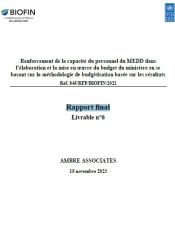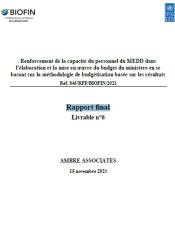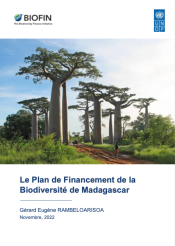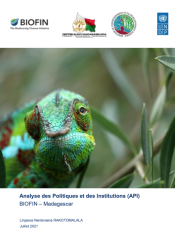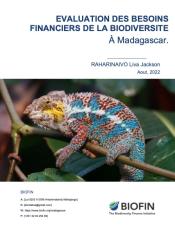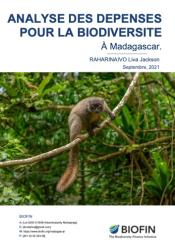Madagascar
Madagascar is an island state in the western Indian Ocean. It is the fourth largest island in the world. It stretches 1,600 km from north to south and 580 km from east to west. Madagascar is one of the world's biodiversity hotspots, home to around 5% of the world's biodiversity. The country's economy in general is based on the fauna and flora species that provide the raw materials for its production activities. This justifies the place to be given to the values of Malagasy biodiversity in its ecological environment, economy, society and culture. However, the ecological functions and ecosystem services that guarantee the well-being and socio-economic development of the human population are threatened by deforestation, the degradation of natural habitats, land and coastal erosion, the accelerated depletion of natural resources and the disappearance of endemic species. Despite conservation efforts, the threats to biodiversity remain worrying, not least because of the low level of investment in biodiversity.
In 2019, Madagascar joined the Global Biodiversity Finance Initiative (BIOFIN) to develop a Biodiversity Finance Plan (BFP). This methodological phase ended in December 2022 with the finalization of the Biodiversity Financing Plan (BFP) and its validation by the National Steering Committee.
Since January 2023, the program has fully entered its 2nd phase, which consists of implementing some of the financing mechanisms prioritized in the BFP.
- the Policy and Institutional Review (PIR) has shown that although Madagascar's sustainable development depends heavily on the sustainable management of biodiversity, it remains generally poorly integrated into planning, sectoral policies and the national budgeting process. Stakeholders generally have limited human and financial resources, and the NBSAP is only partially implemented.
- The Biodiversity Expenditure Review (BER) showed that public spending on biodiversity conservation remains low, representing less than 3% of the allocated public budget. There is also heavy dependence on donor funding for biodiversity conservation, which is often irregular and unpredictable.
- The financial needs assessment (FNA) showed that the financial requirements to implement the NBSAP (National Biodiversity Strategy and Action Plan) over the period 2022-2025 were around $900 million.
- 14 priority solutions have been identified and validated in the Biodiversity Finance Plan (BFP). These solutions are
- Increase and improve the effectiveness of bi- and multilateral aid for biodiversity.
- Increase revenues from the REDD mechanism in Madagascar by facilitating private sector access to REDD+ financing.
- Improve public budget execution through results-based management (RBM).
- Operationalize ABS by developing the legal framework: bioprospecting
- Debt-for-nature swaps
- Feasibility study on setting up a subsidy for conservation agriculture to reduce deforestation
- Roadmap to access blue carbon market opportunities
- Mobilize additional financial resources to fund the expansion of the network of terrestrial protected areas and marine protected areas.
- Enable the National Forest Fund (FFN) to use collected forest revenues (earmarked for the system) to ensure the sustainable management of forest resources.
- Promotion of sustainable fishing (implementation of the MSP marine space management plan).
- Promotion of sustainable nature-based tourism
- Promotion of natural capital accounting
- Strengthening the legal framework for Environmental Impact Assessments, ERIPs and biodiversity offsetting.
- Corporate social responsibility (CSR) in favor of biodiversity
3 financing solutions are currently being implemented. In addition, the BIOFIN Madagascar team is conducting a study of the country's financial sector:
- Financing solution 1: Improving public budget execution through results-based management (RBM).
The aim of this support is to strengthen the capacity of MEDD-appointed technicians involved in drawing up the Ministry's budget at central and regional level, and in implementing it using results-based budgeting methodology.
- Financing solution 2: Diversify and increase funding sources for institutions financing protected areas
This solution is aiming to diversify and mobilize additional sources of funding for FAPBM, Tany Meva and MNP.
- Financing solution 3: Mobilize financial resources to ensure sustainable management of forest resources.
The financing solution aims to mobilize additional financial resources for sustainable forest management by revising existing fees, royalties, fines and penalties related to the forestry sector, improving their collection and supporting the capitalization and operationalization of the national forest fund (FFN) currently being created.
- Study on Madagascar's readiness to disclose nature-related financial information.
This study consists of an in-depth policy, regulatory and institutional analysis with a view to establishing an enabling environment and incentives/disincentives to increase the adoption of the nature-related financial disclosure framework.
The PIR identifies national biodiversity vision, strategies and trends. In addition to showing that biodiversity remains poorly integrated into planning, sectoral policies and the national budgeting process, and that stakeholders generally have weak human and financial resources and the NBSAP is only partially implemented, the PIR identified/underlined:
- Twenty-four existing financing solutions for biodiversity.
- Subsidies harmful to biodiversity in the agricultural sector (e.g. taxes on agricultural inputs).
- The MEDD already has an important structure for biodiversity, which needs financial, technical and, above all, human resources to be effective.
- The MEDD cannot protect biodiversity on its own. Other sectors depend on and derive a large part of their benefits from biodiversity, and should therefore contribute.
- The development of a legal and institutional framework for private-sector involvement in biodiversity management and financing needs to be strengthened.
- Policies and laws for all sectors in Madagascar should explicitly consider the environment and biodiversity in their implementation.
- For protected areas, it is important to know the economic contribution of protected areas in Madagascar. This would enable additional financial resources to be mobilized, and a sustainable financing strategy for protected areas to be developed and implemented.
- The ecological compensation system will also be strengthened by developing a legal and institutional framework.
- Officials in the Ministry of Justice should be made aware of the economic importance of biodiversity for Madagascar, and their capacities should be strengthened in line with the international legal framework on biodiversity.
- In the agricultural sector, while the use of chemical inputs may seem indispensable in the short term, it is very important that the country can support farmers in optimizing their use and reducing their negative impact on biodiversity.
- Locally-managed marine areas in Madagascar must be supported and helped to finance their sustainable management.
- Public-sector spending on biodiversity conservation amounted to US$41.69 million over the 5-year study period. NGO and foundation spending, based on the sample taken, amounted to US$57.7 million. In short, biodiversity funding is dominated by environmental NGOs and foundations. This funding is heavily dependent on external sources.
- Government spending on investment is low (23%) compared with operating expenditure (77%). The involvement of other ministries in addition to the Environment and Agriculture ministries in incentive programs for biodiversity protection.
- The involvement of the private sector in financing biodiversity is important. We need to raise their awareness and knowledge of national and international obligations relating to the sustainable management and conservation of biodiversity and natural resources.
- The framework and implementation of environmental impact assessments must be strengthened.
- Develop partnerships between the private sector, civil society, local authorities and communities to implement management plans and facilitate the restoration of biodiversity, and finally facilitate the mobilization of financial resources for the private sector to implement nature-based solutions.
The aim of the Biodiversity Financial Needs Assessment (FNA) is to provide a comprehensive estimate of the financial resources required to achieve national biodiversity targets. These objectives are based on the NBSAP (2015 - 2025) and more precisely on the remaining period of the NBSAP, which runs from 2022 to 2025. The NBSAP is made up of 05 strategic axes and 20 Objectives.
To carry out this EBF, BIOFIN Madagascar drew up a logical framework for the NBSAP, classifying the activities proposed by various stakeholders (public sector, private sector and NGOs). Each activity was detailed, and one or more targets and key players were identified. Over 500 activities were identified during the data collection carried out by the NBSAP logframe consulting team.
The costs of implementing these activities were then estimated, and the activities were budgeted by determining their unit cost. Following this, it was possible to estimate the funding requirements for biodiversity conservation in Madagascar at 3.6 thousand billion Ariary, or just under 900 million USD for the period 2022-2025. In addition to the very substantial funding requirement, it was also identified that reforestation activities and the restoration and management of protected areas account for the bulk of NBSAP implementation costs.
The Madagascar Biodiversity Financing Plan started with an identification of 85 used and potential financing solutions for Madagascar, and ended with 14 prioritized financing solutions for the sustainable management of Madagascar's biodiversity.
The 14 prioritized solutions are :
- SF 01: Debt-for-nature swap
- SF 02: Mobilize financial resources to ensure sustainable management of forest resources
- SF 03: Set up a coordination platform for Protected Area (PA) managers to improve the efficiency of PA management, maximize available resources and support the mobilization of additional resources.
- SF 04: Increase REDD+ revenues, by facilitating access to REDD+ financing by the private sector in Madagascar.
- SF 05: Strengthen the legal framework for Environmental Impact Assessments and Environmental Commitment Programs (PREE) and biodiversity offsetting
- SF 06: Promotion of sustainable fishing (application of the Marine Spatial Plan-MSP)
- SF 07: Roadmap to access blue carbon market opportunities
- SF 08: Increase and improve the effectiveness of bi- and multilateral aid for biodiversity
- SF 09: Improve public budget execution through results-based management (RBM)
- SF 10: Development and implementation of a sustainable financing plan to promote climate-smart agriculture (CSA) in land-clearing areas
- SF 11: Promote sustainable tourism for biodiversity management
- SF 12: Promote capacity building in Ministries on natural capital accounting and improve data sharing to enhance budget planning
- SF 13: Operationalize the framework for Access to Genetic Resources and Fair and Equitable Sharing of the Benefits Arising out of their Utilization (ABS) by developing the legal framework
- SF14: Corporate Social Responsibility (CSR) in favor of Biodiversity
